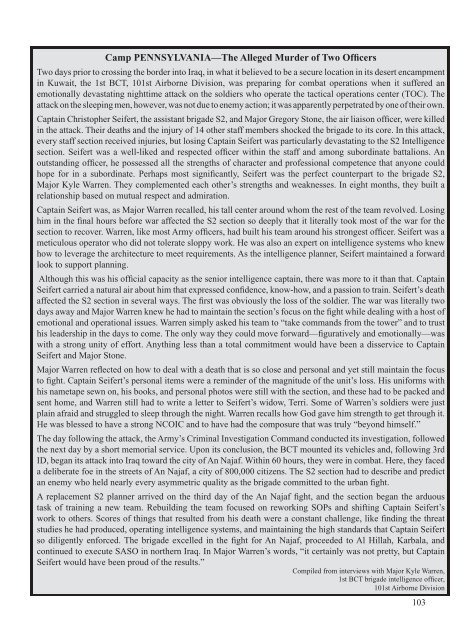On Point: the United States Army in Operation Iraqi ... - Boekje Pienter
On Point: the United States Army in Operation Iraqi ... - Boekje Pienter
On Point: the United States Army in Operation Iraqi ... - Boekje Pienter
You also want an ePaper? Increase the reach of your titles
YUMPU automatically turns print PDFs into web optimized ePapers that Google loves.
Camp PENNSYLVANIA—The Alleged Murder of Two OfficersTwo days prior to cross<strong>in</strong>g <strong>the</strong> border <strong>in</strong>to Iraq, <strong>in</strong> what it believed to be a secure location <strong>in</strong> its desert encampment<strong>in</strong> Kuwait, <strong>the</strong> 1st BCT, 101st Airborne Division, was prepar<strong>in</strong>g for combat operations when it suffered anemotionally devastat<strong>in</strong>g nighttime attack on <strong>the</strong> soldiers who operate <strong>the</strong> tactical operations center (TOC). Theattack on <strong>the</strong> sleep<strong>in</strong>g men, however, was not due to enemy action; it was apparently perpetrated by one of <strong>the</strong>ir own.Capta<strong>in</strong> Christopher Seifert, <strong>the</strong> assistant brigade S2, and Major Gregory Stone, <strong>the</strong> air liaison officer, were killed<strong>in</strong> <strong>the</strong> attack. Their deaths and <strong>the</strong> <strong>in</strong>jury of 14 o<strong>the</strong>r staff members shocked <strong>the</strong> brigade to its core. In this attack,every staff section received <strong>in</strong>juries, but los<strong>in</strong>g Capta<strong>in</strong> Seifert was particularly devastat<strong>in</strong>g to <strong>the</strong> S2 Intelligencesection. Seifert was a well-liked and respected officer with<strong>in</strong> <strong>the</strong> staff and among subord<strong>in</strong>ate battalions. Anoutstand<strong>in</strong>g officer, he possessed all <strong>the</strong> strengths of character and professional competence that anyone couldhope for <strong>in</strong> a subord<strong>in</strong>ate. Perhaps most significantly, Seifert was <strong>the</strong> perfect counterpart to <strong>the</strong> brigade S2,Major Kyle Warren. They complemented each o<strong>the</strong>r’s strengths and weaknesses. In eight months, <strong>the</strong>y built arelationship based on mutual respect and admiration.Capta<strong>in</strong> Seifert was, as Major Warren recalled, his tall center around whom <strong>the</strong> rest of <strong>the</strong> team revolved. Los<strong>in</strong>ghim <strong>in</strong> <strong>the</strong> f<strong>in</strong>al hours before war affected <strong>the</strong> S2 section so deeply that it literally took most of <strong>the</strong> war for <strong>the</strong>section to recover. Warren, like most <strong>Army</strong> officers, had built his team around his strongest officer. Seifert was ameticulous operator who did not tolerate sloppy work. He was also an expert on <strong>in</strong>telligence systems who knewhow to leverage <strong>the</strong> architecture to meet requirements. As <strong>the</strong> <strong>in</strong>telligence planner, Seifert ma<strong>in</strong>ta<strong>in</strong>ed a forwardlook to support plann<strong>in</strong>g.Although this was his official capacity as <strong>the</strong> senior <strong>in</strong>telligence capta<strong>in</strong>, <strong>the</strong>re was more to it than that. Capta<strong>in</strong>Seifert carried a natural air about him that expressed confidence, know-how, and a passion to tra<strong>in</strong>. Seifert’s deathaffected <strong>the</strong> S2 section <strong>in</strong> several ways. The first was obviously <strong>the</strong> loss of <strong>the</strong> soldier. The war was literally twodays away and Major Warren knew he had to ma<strong>in</strong>ta<strong>in</strong> <strong>the</strong> section’s focus on <strong>the</strong> fight while deal<strong>in</strong>g with a host ofemotional and operational issues. Warren simply asked his team to “take commands from <strong>the</strong> tower” and to trusthis leadership <strong>in</strong> <strong>the</strong> days to come. The only way <strong>the</strong>y could move forward—figuratively and emotionally—waswith a strong unity of effort. Anyth<strong>in</strong>g less than a total commitment would have been a disservice to Capta<strong>in</strong>Seifert and Major Stone.Major Warren reflected on how to deal with a death that is so close and personal and yet still ma<strong>in</strong>ta<strong>in</strong> <strong>the</strong> focusto fight. Capta<strong>in</strong> Seifert’s personal items were a rem<strong>in</strong>der of <strong>the</strong> magnitude of <strong>the</strong> unit’s loss. His uniforms withhis nametape sewn on, his books, and personal photos were still with <strong>the</strong> section, and <strong>the</strong>se had to be packed andsent home, and Warren still had to write a letter to Seifert’s widow, Terri. Some of Warren’s soldiers were justpla<strong>in</strong> afraid and struggled to sleep through <strong>the</strong> night. Warren recalls how God gave him strength to get through it.He was blessed to have a strong NCOIC and to have had <strong>the</strong> composure that was truly “beyond himself.”The day follow<strong>in</strong>g <strong>the</strong> attack, <strong>the</strong> <strong>Army</strong>’s Crim<strong>in</strong>al Investigation Command conducted its <strong>in</strong>vestigation, followed<strong>the</strong> next day by a short memorial service. Upon its conclusion, <strong>the</strong> BCT mounted its vehicles and, follow<strong>in</strong>g 3rdID, began its attack <strong>in</strong>to Iraq toward <strong>the</strong> city of An Najaf. With<strong>in</strong> 60 hours, <strong>the</strong>y were <strong>in</strong> combat. Here, <strong>the</strong>y faceda deliberate foe <strong>in</strong> <strong>the</strong> streets of An Najaf, a city of 800,000 citizens. The S2 section had to describe and predictan enemy who held nearly every asymmetric quality as <strong>the</strong> brigade committed to <strong>the</strong> urban fight.A replacement S2 planner arrived on <strong>the</strong> third day of <strong>the</strong> An Najaf fight, and <strong>the</strong> section began <strong>the</strong> arduoustask of tra<strong>in</strong><strong>in</strong>g a new team. Rebuild<strong>in</strong>g <strong>the</strong> team focused on rework<strong>in</strong>g SOPs and shift<strong>in</strong>g Capta<strong>in</strong> Seifert’swork to o<strong>the</strong>rs. Scores of th<strong>in</strong>gs that resulted from his death were a constant challenge, like f<strong>in</strong>d<strong>in</strong>g <strong>the</strong> threatstudies he had produced, operat<strong>in</strong>g <strong>in</strong>telligence systems, and ma<strong>in</strong>ta<strong>in</strong><strong>in</strong>g <strong>the</strong> high standards that Capta<strong>in</strong> Seifertso diligently enforced. The brigade excelled <strong>in</strong> <strong>the</strong> fight for An Najaf, proceeded to Al Hillah, Karbala, andcont<strong>in</strong>ued to execute SASO <strong>in</strong> nor<strong>the</strong>rn Iraq. In Major Warren’s words, “it certa<strong>in</strong>ly was not pretty, but Capta<strong>in</strong>Seifert would have been proud of <strong>the</strong> results.”Compiled from <strong>in</strong>terviews with Major Kyle Warren,1st BCT brigade <strong>in</strong>telligence officer,101st Airborne Division103
















